Technology
UPchieve, an online tutor app for low-income students, launches a free tool for teachers

UPchieve, the free, 24/7 online tutoring and college counseling app for low-income students, announced Thursday it’s giving teachers in Title 1 middle schools and high schools a new tool to ensure their students get the academic support they need.
The new offering, called “UPchieve for Teachers,” allows teachers to offer 1:1 support to their students. They can invite students to sign up for tutoring, create classes, and monitor students’ platform usage. Previously, students had to sign up for tutoring services themselves, but with this new product, teachers can now recommend students for 1:1 tutoring at no cost. In the coming weeks, they’ll also be able to assign tutoring sessions to entire classes.
UPchieve for Teachers is available to educators working in Title 1 middle schools and high schools. Title 1 is a federal aid program provided to K-12 schools with the highest number of low-income families within school districts. Approximately 43% of public schools qualify for Title I funding, with fewer than 50,000 schools benefiting from the program.
This new offering is expected to help UPchieve expand its user base by reaching students who may not be aware of free services like this or who may not be actively seeking additional assistance.
“The product is going to be really valuable to teachers because it’s going to help them accomplish some of the hardest parts of their job,” founder Aly Murray told TechCrunch. “Students are coming into the class with different gaps in their foundational skills. Teachers have to try to support all of their students, but there’s not enough time to support each student individually, so that’s a natural place where a tutor can help. We’re really excited about launching a product that’s going to give teachers more control.”

UPchieve was founded in 2016, shortly after Murray graduated from the University of Pennsylvania. As a former low-income student herself, she struggled to access academic support services throughout her schooling and wanted to make it easy for other students to be able to get help whenever they needed it, even when working on homework late at night.
“I was raised by a single mom, and as an immigrant to the United States, she often wasn’t able to help me with schoolwork and with my college applications. And so that had a big impact on my life. It made things very difficult, and I found that I often needed help late at night when there was really nowhere I could turn to for support,” Murray said.
UPchieve says it has matched over 190,000 tutoring requests from more than 20,000 students across all 50 states. Its 24/7 online tutoring sessions are conducted in the in-app messenger or via voice chat on the web or mobile app. UPchieve covers over 30 subjects, including math, science, English, history, humanities, and more.
Tutors can volunteer by signing up on the website. Volunteers can even be students themselves; however, they must be in 9th grade or higher. UPchieve currently has around 2,400 tutors active on the platform.
“All of the volunteers on UPchieve go through a background screening, training, and certification process to become a volunteer tutor. Before they’re ever going to work with a student, they have to pass a quiz in every subject that they want to help students with,” Murray explained.

Similar to other edtech companies, the company utilizes OpenAI’s GPT-4o to assist tutors in providing AI-generated feedback and progress reports to students after the sessions are over. In the future, the company also plans to use AI to help tutors create practice problems and offer AI-generated summaries of student sessions through its Teachers product.
“We have no plans to replace our human tutors with AI tutors anytime in the near future,” Murray added.
As a nonprofit organization, UPchieve relies on charitable donations, grants, and paid partnerships with schools, districts, and corporations. Donors include Atlassian, AT&T, the Bill & Melinda Gates Foundation, Guggenheim Capital, Goldman Sachs, J.P. Morgan, the Skyline Foundation, and Verizon.
UPchieve has partnered with over 50 schools, and each school or organization pays a $10,000 partnership fee per year or is sponsored by a donor or corporation who pays the fee on their behalf. The company also graduated from Y Combinator’s Winter 2021 batch.
In 2023, UPchieve raised over $4 million through philanthropy and earned revenue from paid partnerships. The company claims its annual recurring revenue (ARR) is currently $840,000, which comes solely from paid and sponsored partnerships.
Technology
This $75 million blockbuster was reportedly shot on an iPhone


The highly anticipated horror flick 28 Years Later was shot entirely on the iPhone 15, Wired claimed in a report on Thursday, noting that with a budget of $75 million, it’s is the biggest movie yet to use a smartphone for filming.
The main filming for the Danny Boyle movie finished up last month and the final product is expected to land in theaters in June 2025. Those working on set had reportedly been instructed to sign a non-disclosure agreement to ensure news didn’t leak about the use of the iPhone. It’s possible that Apple and the moviemakers had been planning a big reveal to highlight the powerful capabilities of the iPhone when it comes to capturing moving pictures, but Wired’s report may impact that plan.
It was first suggested that Boyle was using a smartphone for at least some of the shots for 28 Years Later after a photo of the movie set taken by a paparazzi in July revealed, on close inspection, a protective cage holding something that was most definitely not a regular movie camera but instead, quite possibly, a high-end smartphone.
Wired investigated further and received confirmation from several people linked to the movie that Boyle had indeed been using a number of iPhone 15 Pro Max handsets — connected to elaborate rigs — to film scenes for 28 Years Later.
Having a prominent moviemaker like Danny Boyle use an iPhone for a big-budget movie is a real boon for Apple, which sells a lot of its smartphones off the back of the handset’s strong reputation for producing excellent imagery.
Apple itself also showed off the phone’s ability to record footage for elaborate productions during its Scary Fast event last October in which introduced the new MacBook Pro and iMac with M3 chips. All of the presenters, locations, and drone footage in the online presentation were filmed using the iPhone 15 Pro Max, though as many reports noted at the time — and which also applies to 28 Years Later — the phone was supported by a plethora of advanced moviemaking equipment such as lighting, dollies, and cranes, and also had a highly experienced post-production team to craft the footage into something compelling. The results are astonishing for such a tiny device, so we’re eager to see what Boyle has managed to do with it.
Technology
Google funds FireSat launch to detect and track wildfires
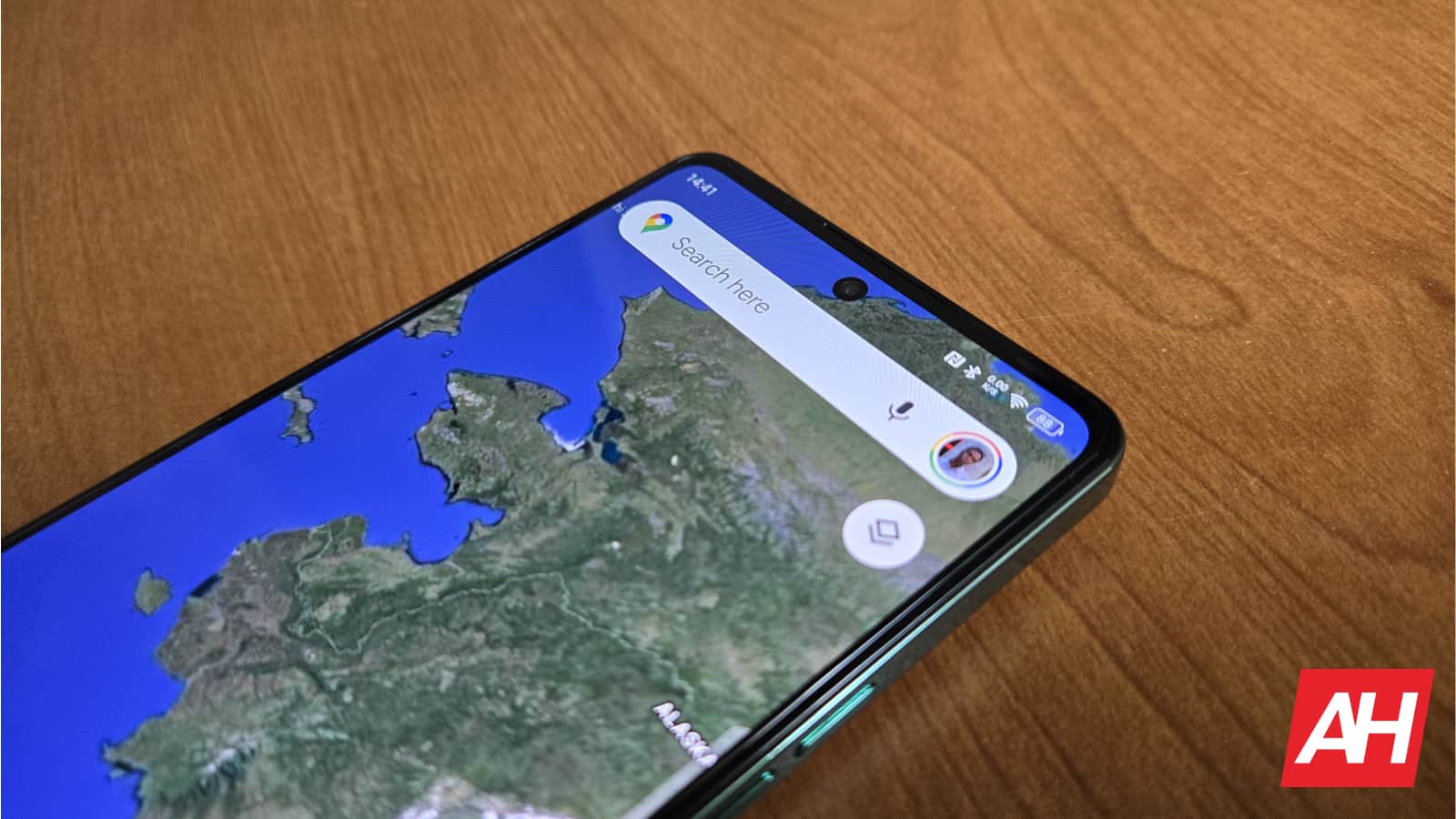
Google has backed FireSat, a constellation of satellites intended to detect, track, and perhaps even prevent wildfires from spreading. The first satellite in the FireSat program is expected to launch early next year.
Google is backing the FireSat satellite launch
Google Maps and Search services have been alerting users about nearby wildfire boundaries since 2020. The search giant has been mapping the wildfires in detail ensuring users are aware of the potential danger. Google also sends notifications and instructions on how to stay safe.
Google has infused $13m into an initiative led by the Earth Fire Alliance that aims to “detect and track wildfires the size of a classroom within 20 minutes”. A blog post published this week details FireSat. Essentially, it is a new constellation of satellites to monitor, detect, and track early-stage wildfires.
In addition to financially backing FireSat, Google Research will also contribute to this project. The entire platform will have Artificial Intelligence (AI) to provide a better way to monitor and manage wildfires.
Google has indicated that the Google Research team will plug relevant data into Machine Learning (ML) technology. This would help develop AI-driven enhancements aimed at detecting wildfires when they are small.
How will FireSat help detect wildfires and save lives?
Wildfires are notoriously difficult to detect. Oftentimes, there are false alarms. Moreover, current-generation satellite imagery used for wildfire detection has low-resolution imagery and infrequent updates.
All these restrictions usually mean wildfires remain undetected until they become as large as football fields. Needless to say, such delays allow wildfires to rapidly expand, destroy habitats, and threaten nearby towns. Google and the FireSat constellation aim to bring down, or perhaps eliminate, the aforementioned limitations, and speed up detection.
The first FireSat satellite, which Google is helping launch, is expected to happen early next year. Fully deployed, this constellation should have 50 satellites in low-earth orbit.
The FireSat satellites are equipped with infrared sensors that detect small fires. Some reports suggest the constellation could eventually detect a fire as small as 5 by 5 meters or about the size of a classroom.
FireSat should be able to provide accurate and actionable information about the location, size, and intensity of early-stage wildfires. This early detection, coupled with real-time updates, could mean agencies can douse wildfires before they pose any serious threat.
Technology
What is CrowdStrike? Everything You Need to Know

In this video, we delve into what CrowdStrike is, how its Falcon software works, and the recent update incident that impacted millions of Windows machines.
Science & Environment
Creature that washed up on New Zealand beach may be world’s rarest whale — a spade-toothed whale
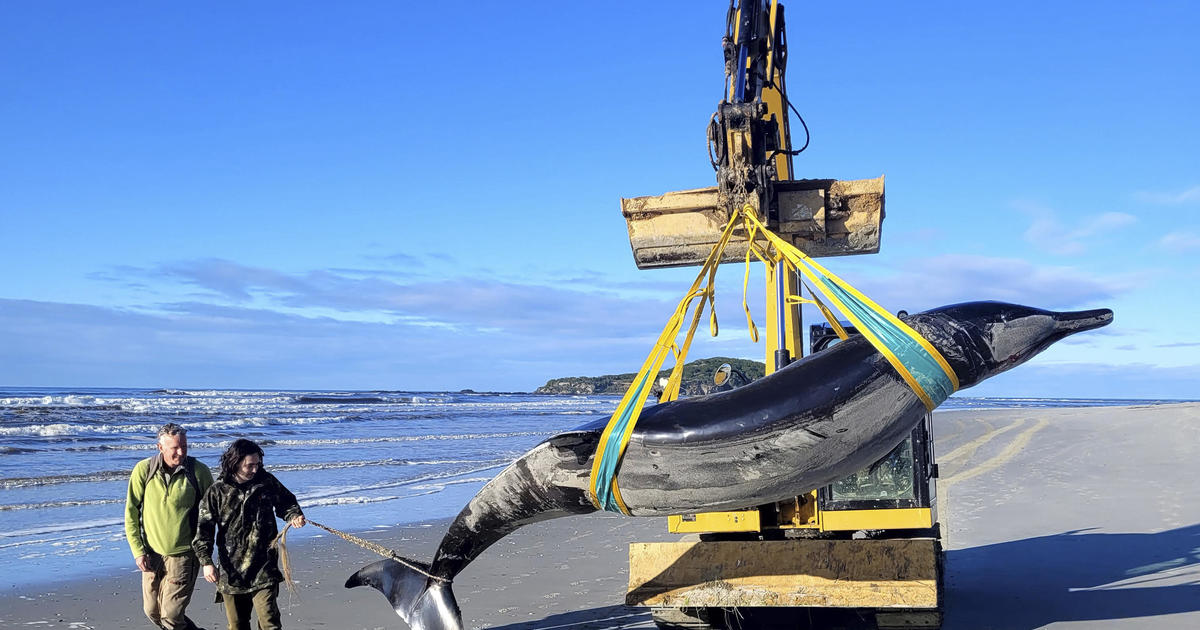
Wellington, New Zealand — Spade-toothed whales are the world’s rarest, with no live sightings ever recorded. No one knows how many there are, what they eat, or even where they live in the vast expanse of the southern Pacific Ocean. However, scientists in New Zealand may have finally caught a break.
The country’s conservation agency said Monday a creature that washed up on a South Island beach this month is believed to be a spade-toothed whale. The five-meter-long creature, a type of beaked whale, was identified after it washed ashore on Otago beach from its color patterns and the shape of its skull, beak and teeth
“We know very little, practically nothing” about the creatures, Hannah Hendriks, Marine Technical Advisor for the Department of Conservation, told The Associated Press. “This is going to lead to some amazing science and world-first information.”
If the cetacean is confirmed to be the elusive spade-toothed whale, it would be the first specimen found in a state that would permit scientists to dissect it, allowing them to map the relationship of the whale to the few others of the species found and learn what it eats and perhaps lead to clues about where they live.
Only six other spade-toothed whales have ever been pinpointed, and those found intact on New Zealand’s North Island beaches had been buried before DNA testing could verify their identification, Hendriks said, thwarting any chance to study them.
This time, the beached whale was quickly transported to cold storage and researchers will work with local Māori iwi (tribes) to plan how it will be examined, the conservation agency said.
New Zealand’s Indigenous people consider whales a taonga – a sacred treasure – of cultural significance. In April, Pacific Indigenous leaders signed a treaty recognizing whales as “legal persons,” although such a declaration is not reflected in the laws of participating nations.
Nothing is currently known about the whales’ habitat. The creatures deep-dive for food and likely surface so rarely that it has been impossible to narrow their location further than the southern Pacific Ocean, home to some of the world’s deepest ocean trenches, Hendriks said.
“It’s very hard to do research on marine mammals if you don’t see them at sea,” she said. “It’s a bit of a needle in a haystack. You don’t know where to look.”
The conservation agency said the genetic testing to confirm the whale’s identification could take months.
It took “many years and a mammoth amount of effort by researchers and local people” to identify the “incredibly cryptic” mammals, Kirsten Young, a senior lecturer at the University of Exeter who has studied spade-toothed whales, said in emailed remarks.
The fresh discovery “makes me wonder – how many are out in the deep ocean and how do they live?” Young said.
The first spade-toothed whale bones were found in 1872 on New Zealand’s Pitt Island. Another discovery was made at an offshore island in the 1950s, and the bones of a third were found on Chile’s Robinson Crusoe Island in 1986. DNA sequencing in 2002 proved that all three specimens were of the same species – and that it was one distinct from other beaked whales.
Researchers studying the mammal couldn’t confirm if the species went extinct. Then in 2010, two whole spade-toothed whales, both dead, washed up on a New Zealand beach. Firstly mistaken for one of New Zealand’s 13 other more common types of beaked whale, tissue samples – taken after they were buried – revealed them as the enigmatic species.
New Zealand is a whale-stranding hotspot, with more than 5,000 episodes recorded since 1840, according to the Department of Conservation.
Technology
5 data governance framework examples

Organizations that treat their data as an asset have a data governance framework that matches their style, structure and culture.
Organizations of all sizes collect, store and process data from numerous sources, including customers, employees and business partners. Without proper oversight, they can miss valuable insights, violate privacy regulations and make decisions based on inaccurate or incomplete information. They might encounter other data issues such as inconsistencies, errors and duplications.
A data governance framework provides a structured, consistent approach to manage data assets and treat data as a valuable resource that supports business strategy. Data governance frameworks consist of policies, processes and standards that define how to collect, store, use and protect data throughout its lifecycle.
Establishing guidelines and best practices through a data governance framework helps organizations ensure regulatory compliance, improve data quality and develop transparent data management practices. A practical framework gives data users confidence in data reporting, analysis and planning. By demonstrating a commitment to responsible data management, organizations can build trust among their stakeholders, including customers, partners and regulators.
Pillars of a data governance framework
An effective data governance framework is built on four essential pillars: data quality, data security and privacy, data ownership and accountability, and data governance metrics.
Data quality
Data quality measures whether the data fits its intended purpose. High-quality data is accurate, complete, consistent and timely. It is the core of any data initiative.
A governance framework needs four essential procedures to establish and maintain good-quality data:
- Regular profiling to assess data and identify quality issues.
- Cleansing and validating to remove errors and inconsistencies.
- Defining data quality metrics to measure and monitor quality over time.
- Implementing data quality controls throughout the data lifecycle.
Data security and privacy
Organizations are susceptible to a wide range of security issues. IT teams might need a better handle on where their vulnerabilities lie. Organizations should ensure their data governance framework includes security and privacy measures to safeguard their data assets and comply with relevant regulations, such as GDPR and CCPA. A strong governance framework contains several elements to regulate data access and usage by members of the organization:
- Implement strong access controls and authentication mechanisms.
- Encrypt sensitive data at rest and as it moves around the network.
- Monitor data access and usage to detect and prevent unauthorized activities.
- Develop and enforce data privacy policies and procedures.
- Conduct security audits and risk assessments to identify and address vulnerabilities.
Data ownership and accountability
Clear ownership and accountability ensures consistent and responsible data management throughout the data lifecycle. Well-defined data ownership and stewardship roles can prevent data silos, inconsistencies and errors that occur from uncoordinated or unassigned data management. A framework should support key aspects of accountability:
- Establish data owners and stewards responsible for disparate data domains or assets.
- Define transparent processes for data access, modification and sharing.
- Create a data governance council or committee to oversee data governance initiatives.
- Promote a culture of data responsibility and collaboration across the organization.
Data governance metrics
Measuring the effectiveness of data governance initiatives enables continuous management and demonstrates the value of data governance to stakeholders. Organizations should define key performance indicators or metrics to track the progress of their data governance efforts:
- Develop dashboards and reports to monitor data quality, security and usage.
- Track the adoption and compliance with data governance policies and standards.
- Measure the relationship of data governance to business objectives.
Data governance framework examples
Organizations can adopt various approaches when implementing a data governance framework depending on their specific needs, structure and culture. Organizations should consider five standard data governance framework models.
Center-out model
The center-out model establishes a centralized data governance body, such as a data governance council or committee. They define and oversee governance policies and standards. The model balances enterprise-wide consistency with some flexibility for individual business units’ specific needs. It also promotes collaboration and communication between the central governance team and data stakeholders.
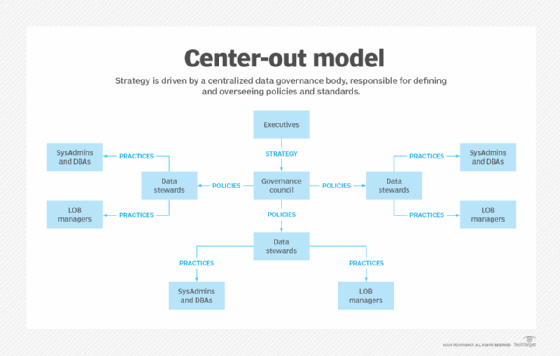
The Data Governance Institute’s Data Governance Framework is a center-out model that emphasizes establishing a Data Governance Office and Board. The framework comprises 10 critical components that address the rules, people, organizational bodies and processes required for effective data governance. The components include defining the mission and vision, establishing goals and metrics, identifying data rules and definitions, assigning decision rights and accountabilities, and implementing controls. The framework also emphasizes the importance of data stakeholders and assigns data stewards to ensure the program’s success. It has hybrid flexibility for business units and data domains, but the Data Governance Office remains critical.
PwC, one of the world’s largest professional services networks, also recommends a centralized approach to meet compliance requirements and avoid business risks. However, PwC sees it as a step to help organizations better monetize their data assets. The PwC model emphasizes a centralized data governance program for consistency across business lines and to reduce the risk of data silos and missed opportunities.
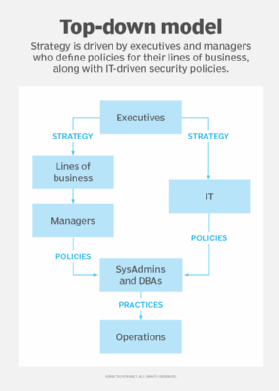
Top-down model
In the top-down model, executive leadership and senior management drive data governance. The approach ensures that governance initiatives align with the organization’s strategic goals and priorities. It also provides the necessary authority and resources to enforce policies and standards across the enterprise. However, it might require more support from business units and stakeholders that feel disconnected from the governance process.
The global management consulting firm McKinsey describes a framework for effective governance that focuses on creating business value and enabling digital and analytics initiatives. The framework’s key elements involve securing top management’s attention and buy-in for data governance and integrating data governance with primary business transformation themes. McKinsey’s model proposes a central data management office, but emphasizes that executive leadership reinforces a solid top-down process.
Hybrid model
The hybrid approach combines concepts from other models to create a customized strategy that suits the organization’s unique needs and structure. For example, an organization might establish a central data governance council to set enterprise-wide policies and standards. They can also empower business units to implement local governance practices aligned with the central framework. It offers the benefits of centralized control and decentralized flexibility.
The Eckerson Group’s Modern Data Governance Framework is a hybrid model. It combines elements of centralized governance through methods, processes and technology with decentralized flexibility with an emphasis on people, culture and the need to adapt to the specific requirements of different stakeholders. The framework stresses the importance of involving a wide range of people, from sponsors and owners to stewards, curators, coaches and consumers. The goal is to build a roadmap for governance as a living document, that is revisited regularly to adapt to changes in priorities or needs.
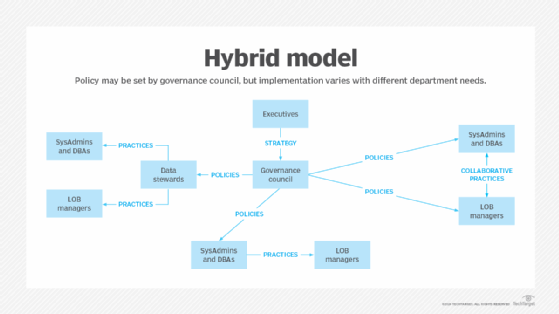
Bottom-up model
The bottom-up model involves data stakeholders and subject matter experts from across the organization in the governance process. The model encourages collaboration and buy-in from people closest to the data, which ensures that governance policies and procedures are practical, relevant and effective.
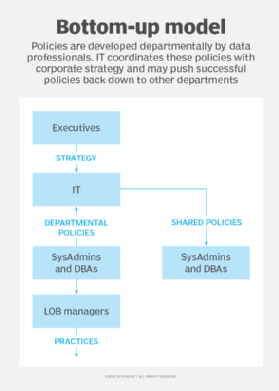
DAMA, a well-known community of data management professionals, developed the Data Management Body of Knowledge (DMBOK). The comprehensive model defines the standard functions and activities related to data management within an organization. Its functions cover the entire data lifecycle, including planning, architecture, development, operations and quality management.
The DAMA-DMBOK framework is flexible, but it’s commonly used as a bottom-up approach because DAMA members typically drive initiatives from the IT department. Over time, they gain executive support and a more formalized adoption as stakeholders can show their success.
Silo-in model
A silo-in allows individual business units or departments to establish data governance practices and standards for their specific needs and requirements.
However, it can lead to inconsistency, duplication of effort and a lack of enterprise-wide coordination. The model suits organizations with highly independent business units or limited enterprise-wide data integration needs.
Few consulting firms or software vendors recommend the silo-in model because data silos are seen as problematic for governance. In practice, many data governance programs start tentatively in isolated business units that have problems to deal with or data that is especially valuable or vulnerable.
When organizations do not adopt a formal data governance framework, they often default to a silo-in approach due to practical considerations. Business units may recognize the need for governance within their domain and take the initiative to establish practices and standards that address their specific pain points or opportunities. The factors that drive the need for governance within the specific unit can include the following:
- Regulatory compliance requirements that apply to specific business units or data domains.
- The need to improve data quality and consistency within a particular business function.
- The desire to use data assets for competitive advantage or innovation within a specific market or product line.
Localized efforts can deliver benefits within their limited scope, but they often need to consider the broader enterprise context and can create challenges down the line. As the organization matures and seeks to use data assets holistically, siloed governance practices can become barriers to integration, interoperability and scale.
If a silo-in approach emerges as the starting point for data governance in an organization, it is essential to recognize its limitations and plan for a transition to a more enterprise-wide model over time:
- Identify and prioritize data domains that cut across business units and require a more coordinated approach to governance.
- Establish cross-functional data governance bodies and processes to align practices and standards across the organization.
- Develop and communicate a shared vision and roadmap for data governance that balances local needs with enterprise goals.
- Invest in data integration and master data management capabilities to break down silos and enable data sharing and collaboration.
Choosing a framework
Treating data as an asset involves giving it the same care and maintenance that the most valued corporate assets receive. Implementing a data governance framework requires more than technical effort. The cultural element around ownership and accountability requires consideration of an organization’s unique needs, structure and ethos.
The keys to success for any of the five models is involving the necessary stakeholders, securing executive buy-in for more comprehensive programs and developing a continuous improvement process. A data governance framework should integrate with the organization’s overall business strategy, ensuring that data management aligns with goals and objectives.
Donald Farmer is principal of TreeHive Strategy and advises software vendors, enterprises and investors on data and advanced analytics strategies. He has worked on some of the leading data technologies in the market and previously led design and innovation teams at Microsoft and Qlik.
Science & Environment
Earth will get a second “mini-moon” for 2 months this year

Earth will get a second moon for about two months this year when a small asteroid begins to orbit our planet. The asteroid was discovered in August and is set to become a mini-moon, revolving around Earth in a horseshoe shape from Sept. 29 to Nov. 25.
Researchers at the Asteroid Terrestrial-impact Last Alert System, an asteroid monitoring system funded by NASA, spotted the asteroid using an instrument in Sutherland, South Africa and labeled it 2024 PT5.
Scientists from the Universidad Complutense de Madrid have tracked the asteroid’s orbit for 21 days and determined its future path. 2024 PT5 is from the Arjuna asteroid belt, which orbits the sun, according to their study published in Research Notes of the AAs.
But Earth’s gravitational pull will draw 2024 PT5 towards it and, much like our moon, it will orbit our planet — but only for 56.6 days.
While other non-Earth objects, or NEOs, have entered Earth’s orbit before, some don’t complete full revolutions of Earth. Some, however, do and become so-called mini-moons.
An asteroid called 2020 CD3 was bound to Earth for several years before leaving the planet’s orbit in 2020 and another called 2022 NX1 became a mini-moon of Earth in 1981 and 2022 and will return again in 2051.
2024 PT5, which is larger than some of the other mini-moons, will also return to Earth’s orbit — in 2055.
Earth’s gravity will pull it into its orbit and the asteroid will have negative geocentric energy, meaning it can’t escape Earth’s gravitational pull. It will orbit around Earth in a horseshoe shape before reverting back to heliocentric energy, meaning it will rotate around the sun again, like the other planets and NEOs in our galaxy.
Even after it leaves orbit, it will stay near Earth for a few months, making its closest approach on Jan. 9, 2025. Soon after, it will leave Earth’s neighborhood until its path puts it back into our orbit in about 30 years.
The study’s lead author Carlos de la Fuente Marcos told Space.com the mini-moon will be too small to see with amateur telescopes or binoculars but professional astronomers with stronger tools will be able to spot it.
CBS News has reached out to Marcos for further information and is awaiting response.
-

 Sport14 hours ago
Sport14 hours agoJoshua vs Dubois: Chris Eubank Jr says ‘AJ’ could beat Tyson Fury and any other heavyweight in the world
-

 News2 days ago
News2 days agoYou’re a Hypocrite, And So Am I
-

 News15 hours ago
News15 hours agoIsrael strikes Lebanese targets as Hizbollah chief warns of ‘red lines’ crossed
-

 Sport13 hours ago
Sport13 hours agoUFC Edmonton fight card revealed, including Brandon Moreno vs. Amir Albazi headliner
-

 Science & Environment17 hours ago
Science & Environment17 hours ago‘Running of the bulls’ festival crowds move like charged particles
-

 Technology12 hours ago
Technology12 hours agoiPhone 15 Pro Max Camera Review: Depth and Reach
-

 Science & Environment17 hours ago
Science & Environment17 hours agoHow one theory ties together everything we know about the universe
-

 Science & Environment1 day ago
Science & Environment1 day agoSunlight-trapping device can generate temperatures over 1000°C
-

 News12 hours ago
News12 hours agoBrian Tyree Henry on voicing young Megatron, his love for villain roles
-

 Science & Environment1 day ago
Science & Environment1 day agoQuantum time travel: The experiment to ‘send a particle into the past’
-

 CryptoCurrency14 hours ago
CryptoCurrency14 hours ago2 auditors miss $27M Penpie flaw, Pythia’s ‘claim rewards’ bug: Crypto-Sec
-

 CryptoCurrency14 hours ago
CryptoCurrency14 hours agoBitcoin miners steamrolled after electricity thefts, exchange ‘closure’ scam: Asia Express
-

 CryptoCurrency14 hours ago
CryptoCurrency14 hours agoCardano founder to meet Argentina president Javier Milei
-

 CryptoCurrency14 hours ago
CryptoCurrency14 hours agoDorsey’s ‘marketplace of algorithms’ could fix social media… so why hasn’t it?
-

 CryptoCurrency14 hours ago
CryptoCurrency14 hours agoLow users, sex predators kill Korean metaverses, 3AC sues Terra: Asia Express
-
Business13 hours ago
How Labour donor’s largesse tarnished government’s squeaky clean image
-

 Science & Environment21 hours ago
Science & Environment21 hours agoQuantum ‘supersolid’ matter stirred using magnets
-
News14 hours ago
Freed Between the Lines: Banned Books Week
-

 MMA13 hours ago
MMA13 hours agoUFC’s Cory Sandhagen says Deiveson Figueiredo turned down fight offer
-

 CryptoCurrency13 hours ago
CryptoCurrency13 hours agoEthereum is a 'contrarian bet' into 2025, says Bitwise exec
-

 Science & Environment21 hours ago
Science & Environment21 hours agoA new kind of experiment at the Large Hadron Collider could unravel quantum reality
-

 Science & Environment20 hours ago
Science & Environment20 hours agoHow Peter Higgs revealed the forces that hold the universe together
-

 Science & Environment17 hours ago
Science & Environment17 hours agoRethinking space and time could let us do away with dark matter
-

 Science & Environment14 hours ago
Science & Environment14 hours agoWe may have spotted a parallel universe going backwards in time
-

 CryptoCurrency14 hours ago
CryptoCurrency14 hours agoArthur Hayes’ ‘sub $50K’ Bitcoin call, Mt. Gox CEO’s new exchange, and more: Hodler’s Digest, Sept. 1 – 7
-

 CryptoCurrency14 hours ago
CryptoCurrency14 hours agoTreason in Taiwan paid in Tether, East’s crypto exchange resurgence: Asia Express
-

 CryptoCurrency14 hours ago
CryptoCurrency14 hours agoLeaked Chainalysis video suggests Monero transactions may be traceable
-

 CryptoCurrency14 hours ago
CryptoCurrency14 hours agoJourneys: Robby Yung on Animoca’s Web3 investments, TON and the Mocaverse
-

 CryptoCurrency14 hours ago
CryptoCurrency14 hours agoLouisiana takes first crypto payment over Bitcoin Lightning
-

 CryptoCurrency14 hours ago
CryptoCurrency14 hours agoAre there ‘too many’ blockchains for gaming? Sui’s randomness feature: Web3 Gamer
-

 CryptoCurrency14 hours ago
CryptoCurrency14 hours agoCrypto whales like Humpy are gaming DAO votes — but there are solutions
-

 CryptoCurrency14 hours ago
CryptoCurrency14 hours agoHelp! My parents are addicted to Pi Network crypto tapper
-

 CryptoCurrency14 hours ago
CryptoCurrency14 hours ago$12.1M fraud suspect with ‘new face’ arrested, crypto scam boiler rooms busted: Asia Express
-

 CryptoCurrency14 hours ago
CryptoCurrency14 hours ago‘Everything feels like it’s going to shit’: Peter McCormack reveals new podcast
-

 Science & Environment17 hours ago
Science & Environment17 hours agoWhy we need to invoke philosophy to judge bizarre concepts in science
-

 Science & Environment17 hours ago
Science & Environment17 hours agoFuture of fusion: How the UK’s JET reactor paved the way for ITER
-

 CryptoCurrency14 hours ago
CryptoCurrency14 hours agoSEC sues ‘fake’ crypto exchanges in first action on pig butchering scams
-

 CryptoCurrency14 hours ago
CryptoCurrency14 hours agoFed rate cut may be politically motivated, will increase inflation: Arthur Hayes
-

 CryptoCurrency14 hours ago
CryptoCurrency14 hours agoDecentraland X account hacked, phishing scam targets MANA airdrop
-

 CryptoCurrency14 hours ago
CryptoCurrency14 hours agoCZ and Binance face new lawsuit, RFK Jr suspends campaign, and more: Hodler’s Digest Aug. 18 – 24
-

 CryptoCurrency14 hours ago
CryptoCurrency14 hours agoCertiK Ventures discloses $45M investment plan to boost Web3
-

 CryptoCurrency14 hours ago
CryptoCurrency14 hours agoMemecoins not the ‘right move’ for celebs, but DApps might be — Skale Labs CMO
-

 CryptoCurrency14 hours ago
CryptoCurrency14 hours agoTelegram bot Banana Gun’s users drained of over $1.9M
-

 CryptoCurrency14 hours ago
CryptoCurrency14 hours agoDZ Bank partners with Boerse Stuttgart for crypto trading
-

 CryptoCurrency14 hours ago
CryptoCurrency14 hours agoRedStone integrates first oracle price feeds on TON blockchain
-

 CryptoCurrency14 hours ago
CryptoCurrency14 hours agoBitcoin bulls target $64K BTC price hurdle as US stocks eye new record
-

 CryptoCurrency14 hours ago
CryptoCurrency14 hours agoSEC asks court for four months to produce documents for Coinbase
-

 CryptoCurrency14 hours ago
CryptoCurrency14 hours ago‘No matter how bad it gets, there’s a lot going on with NFTs’: 24 Hours of Art, NFT Creator
-

 CryptoCurrency13 hours ago
CryptoCurrency13 hours agoBlockdaemon mulls 2026 IPO: Report
-
Business13 hours ago
Thames Water seeks extension on debt terms to avoid renationalisation
-
Politics13 hours ago
The Guardian view on 10 Downing Street: Labour risks losing the plot | Editorial
-

 Politics13 hours ago
Politics13 hours agoI’m in control, says Keir Starmer after Sue Gray pay leaks
-
Politics13 hours ago
‘Appalling’ rows over Sue Gray must stop, senior ministers say | Sue Gray
-
Business12 hours ago
UK hospitals with potentially dangerous concrete to be redeveloped
-
Business12 hours ago
Axel Springer top team close to making eight times their money in KKR deal
-

 News12 hours ago
News12 hours ago“Beast Games” contestants sue MrBeast’s production company over “chronic mistreatment”
-

 News12 hours ago
News12 hours agoSean “Diddy” Combs denied bail again in federal sex trafficking case
-

 News12 hours ago
News12 hours agoSean “Diddy” Combs denied bail again in federal sex trafficking case in New York
-

 News12 hours ago
News12 hours agoBrian Tyree Henry on his love for playing villains ahead of “Transformers One” release
-

 News12 hours ago
News12 hours agoBrian Tyree Henry on voicing young Megatron, his love for villain roles
-

 CryptoCurrency11 hours ago
CryptoCurrency11 hours agoCoinbase’s cbBTC surges to third-largest wrapped BTC token in just one week
-

 Technology3 days ago
Technology3 days agoYouTube restricts teenager access to fitness videos
-

 News16 hours ago
News16 hours agoChurch same-sex split affecting bishop appointments
-

 Politics2 days ago
Politics2 days agoTrump says he will meet with Indian Prime Minister Narendra Modi next week
-

 Politics1 day ago
Politics1 day agoWhat is the House of Lords, how does it work and how is it changing?
-

 Politics1 day ago
Politics1 day agoKeir Starmer facing flashpoints with the trade unions
-

 Health & fitness2 days ago
Health & fitness2 days agoWhy you should take a cheat day from your diet, and how many calories to eat
-

 Technology15 hours ago
Technology15 hours agoFivetran targets data security by adding Hybrid Deployment
-

 News4 days ago
News4 days agoNathan Simpson appears in court over murder of Rachelle Simpson
-

 Science & Environment2 days ago
Science & Environment2 days agoElon Musk’s SpaceX contracted to destroy retired space station
-

 Science & Environment21 hours ago
Science & Environment21 hours agoSingle atoms captured morphing into quantum waves in startling image
-

 Business3 days ago
Business3 days agoGuardian in talks to sell world’s oldest Sunday paper
-

 MMA13 hours ago
MMA13 hours agoDiego Lopes declines Movsar Evloev’s request to step in at UFC 307
-

 Football13 hours ago
Football13 hours agoNiamh Charles: Chelsea defender has successful shoulder surgery
-

 Football13 hours ago
Football13 hours agoSlot's midfield tweak key to Liverpool victory in Milan
-

 Science & Environment17 hours ago
Science & Environment17 hours agoHyperelastic gel is one of the stretchiest materials known to science
-

 Science & Environment17 hours ago
Science & Environment17 hours agoHow to wrap your head around the most mind-bending theories of reality
-

 Technology2 days ago
Technology2 days agoCan technology fix the ‘broken’ concert ticketing system?
-

 Fashion Models13 hours ago
Fashion Models13 hours agoMiranda Kerr nude
-

 Fashion Models13 hours ago
Fashion Models13 hours ago“Playmate of the Year” magazine covers of Playboy from 1971–1980
-

 News3 days ago
News3 days agoDid the Pandemic Break Our Brains?
-

 Health & fitness2 days ago
Health & fitness2 days ago11 reasons why you should stop your fizzy drink habit in 2022
-

 Politics12 hours ago
Politics12 hours agoLabour MP urges UK government to nationalise Grangemouth refinery
-

 Technology2 days ago
Technology2 days agoWhat will future aerial dogfights look like?
-

 Science & Environment15 hours ago
Science & Environment15 hours agoOdd quantum property may let us chill things closer to absolute zero
-

 Science & Environment22 hours ago
Science & Environment22 hours agoQuantum forces used to automatically assemble tiny device
-

 Entertainment12 hours ago
Entertainment12 hours ago“Jimmy Carter 100” concert celebrates former president’s 100th birthday
-

 Business3 days ago
Business3 days agoDangers of being a FOMO customer as rates fall
-

 CryptoCurrency14 hours ago
CryptoCurrency14 hours agoSEC settles with Rari Capital over DeFi pools, unregistered broker activity
-

 News12 hours ago
News12 hours agoJoe Posnanski revisits iconic football moments in new book, “Why We Love Football”
-

 Health & fitness2 days ago
Health & fitness2 days agoHow to adopt mindful drinking in 2022
-

 Health & fitness2 days ago
Health & fitness2 days agoWhat 10 days of a clean eating plan actually does to your body and why to adopt this diet in 2022
-

 Health & fitness2 days ago
Health & fitness2 days agoWhen Britons need GoFundMe to pay for surgery, it’s clear the NHS backlog is a political time bomb
-

 Health & fitness2 days ago
Health & fitness2 days agoThe maps that could hold the secret to curing cancer
-

 Business3 days ago
Business3 days ago‘I borrowed £44,000 for university and now owe £54,000’
-

 News4 days ago
News4 days agoCan the middle powers save multilateral trade?
-
Health & fitness2 days ago
Covid v flu v cold and how to tell the difference between symptoms this winter
-

 News3 days ago
News3 days agoAs Democrats fold to GOP on border policy, immigrants pay the price
-

 Science & Environment1 day ago
Science & Environment1 day agoPhysicists determined the paper most likely to give you a paper cut
-

 News4 days ago
News4 days agoBrits’ favourite history periods revealed – does yours make the list?



You must be logged in to post a comment Login